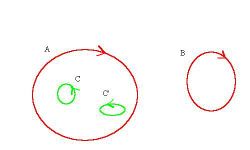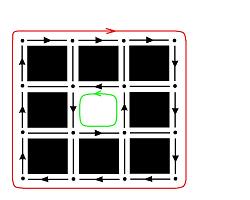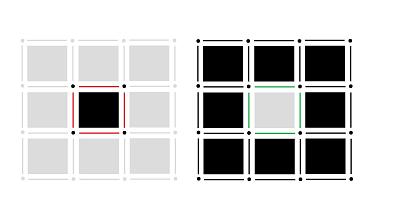This site is being phased out.
Alexander duality
In our analysis of digital images both objects (connected components) and holes are captured by "cycles":
- A $0$-cycle follows the outer boundary of an object,
- A $1$-cycle follows the outer boundary of a hole.
Like this:
Here $A$ and $B$ are $0$-cycles, $C$ and $C’$ are $1$-cycles:
The name “$1$-cycle” is justified by the fact that this is a sequence of edges or $1$-cells. But what about $0$-cycles?
We know though that $0$-cycles are (homologically) represented by vertices.
To understand this we observe that the $1$-cycles of the picture are $0$-cycles of its negative and vice versa, except for ones that touch the border of the image.
For cubical complexes, we define the complement complex $M - K$ as the one of the closure of the complex $K$. Then the relation looks like this:
Conclusion: The contour that represents a $0$-cycle in a $2$-dimensional cubical complex $K$ is, in fact, a $1$-cycle of the closure of the complement of ${\bf R}^2 - K$, and vice versa.
This is an instance of the Alexander duality.
The only trouble is with the components that touch the edge of the image. There is an issue with whether we can "squeeze" a contour between such a component and the border.
To resolve this issue we simply assume that the image, and the complex $K$, is, in fact a subset of a (large) sphere ${\bf S}^2$.
Now we notice however that a one-point complex will have the sphere with a hole as its complement. But that's the disk! Since the disk has no holes, the count is off.
This forces us to use the "reduced" Betti numbers. They simply discount for an extra component.
In that case, the count of the cycles isn't off anymore: $$b_i(K)=b_{1-i}({\bf S}^2-K),$$ where $b_i$ is the $i$-th reduced Betti number.
The general formula of the Alexander duality is $$b_i(K)=b_{n-i-1}(M-K),$$ for any subcomplex $K$ of an $n$-manifold $M$.



